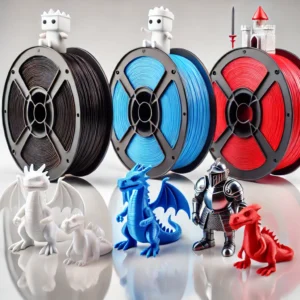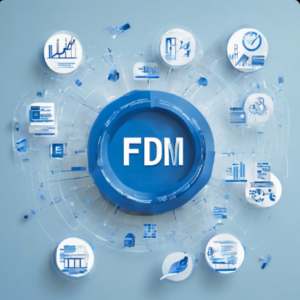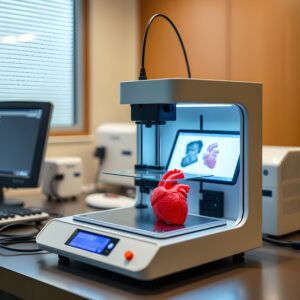FDM vs. SLA: A Comprehensive Technology Comparison

3D printing technologies have revolutionized industries, empowering individuals and businesses to create functional prototypes, intricate designs, and even end-use products. Among the numerous technologies available, Fused Deposition Modeling (FDM) and Stereolithography (SLA) are two of the most widely adopted methods.
While both methods offer distinct advantages, their differences in precision, speed, cost, and material compatibility can determine their suitability for specific applications. This article delves into a detailed comparison of FDM and SLA to help you make an informed choice for your next project.
Understanding the Core Technologies
What is FDM?
Fused Deposition Modeling (FDM) works by extruding a heated thermoplastic filament through a nozzle, layer by layer, to build an object. It is one of the earliest 3D printing technologies and remains popular due to its simplicity and affordability.
-
How It Works:
- The filament is fed through a heated nozzle, where it is melted.
- The printer deposits the material onto a build platform in a precise pattern dictated by the design file.
- Layers adhere to each other as the material cools, gradually forming the object.
-
Common Materials:
- PLA (Polylactic Acid): Biodegradable and beginner-friendly.
- ABS (Acrylonitrile Butadiene Styrene): Durable but prone to warping.
- TPU (Thermoplastic Polyurethane): Flexible and elastic.
-
Advantages:
- Affordable machines and materials.
- Wide variety of filament options.
- Ideal for large-scale models and functional prototypes.
-
Limitations:
- Visible layer lines.
- Limited precision and detail for complex geometries.
What is SLA?
Stereolithography (SLA) utilizes a vat of liquid photopolymer resin that is cured layer by layer using a laser. This technology is renowned for its high resolution and smooth surface finish, making it a favorite for applications requiring intricate details.
-
How It Works:
- A laser beam traces the design onto a thin layer of liquid resin, curing and solidifying it.
- The build platform moves slightly, allowing the next layer of resin to be cured on top of the previous one.
- After printing, the object is washed and exposed to UV light for post-curing.
-
Common Materials:
- Standard Resins: Suitable for general-purpose models.
- Tough Resins: Durable and resistant to impact.
- Flexible Resins: Mimic rubber-like properties.
-
Advantages:
- Exceptional detail and precision.
- Smooth surfaces with minimal post-processing.
- Ideal for small, intricate parts.
-
Limitations:
- Higher costs for printers and consumables.
- Complex handling of resin and waste.
Precision and Accuracy
FDM Precision
The precision of FDM printers is determined by factors like nozzle diameter, layer height, and motion accuracy:
- Layer Height: Typically ranges from 0.1 mm to 0.3 mm. Lower layer heights provide better detail but increase print time.
- Dimensional Tolerances: FDM prints usually achieve tolerances of ±0.2 mm to ±0.3 mm, sufficient for functional prototypes but less suitable for fine details.
- Limitations:
- Imperfections can arise from uneven extrusion or thermal expansion.
- Complex geometries may require support structures, impacting surface quality.
SLA Precision
SLA printers excel in achieving unmatched accuracy due to their laser-based curing process:
- Layer Resolution: SLA printers offer resolutions as fine as 25 microns (0.025 mm), creating highly detailed parts.
- Dimensional Accuracy: Tolerances of ±0.05 mm ensure precision in critical applications like medical devices or jewelry.
- Advantages:
- Can produce intricate geometries with minimal supports.
- Superior detail for aesthetic or functional parts.
Surface Finish
FDM Surface Quality
FDM parts have visible layer lines, which may require post-processing:
- Sanding: Gradual sanding from coarse to fine grit removes layer lines.
- Chemical Smoothing: Solvents like acetone vapor can smooth ABS parts, giving them a polished finish.
- Priming and Painting: Often used for aesthetic improvement in display models.
SLA Surface Quality
SLA parts naturally exhibit smooth surfaces due to their photopolymer resin curing process:
- Minimal Post-Processing: Sanding or polishing is optional but enhances clarity or shine.
- Surface Consistency: Ideal for applications where aesthetics and precision are critical, such as jewelry or dental models.
Speed of Printing
FDM Speed
FDM printers generally excel in producing larger models quickly, though speed varies based on design complexity:
- Simple Geometries: Can be printed faster due to fewer intricate details.
- High Layer Heights: Reducing resolution increases speed but sacrifices detail.
SLA Speed
SLA printers are typically slower due to their meticulous curing process:
- Small Models: SLA performs efficiently for small or intricate parts.
- Parallel Layer Curing: Advanced SLA machines now use multiple lasers or LCD-based systems to speed up layer curing.
Material Options and Costs
FDM Materials
FDM printers support a broad range of thermoplastics:
- PLA: Affordable and eco-friendly, ideal for beginners.
- ABS: Durable and impact-resistant, suitable for functional parts.
- Specialty Filaments: Include carbon fiber composites, wood-filled, and glow-in-the-dark filaments.
SLA Materials
SLA printers work with photopolymer resins tailored for specific applications:
- Biocompatible Resins: Approved for medical uses like surgical guides or dental crowns.
- High-Temperature Resins: Suitable for casting molds or engineering parts.
- Cost of Materials: Resins are priced higher than FDM filaments, averaging $50 to $150 per liter.
Industrial Applications
FDM in Industries
- Prototyping: Rapid and low-cost creation of prototypes in automotive, consumer electronics, and industrial design.
- Education: Affordable and user-friendly for STEM programs in schools.
- Functional Parts: Used for creating jigs, fixtures, and end-use components.
SLA in Industries
- Healthcare: Custom surgical guides, dental implants, and anatomical models.
- Luxury Goods: Intricate molds for jewelry and watches.
- Engineering: Precise prototypes for assembly testing and aerodynamic analysis.
Environmental Impact
FDM
- Sustainability: Filaments like PLA are biodegradable, offering eco-friendly options.
- Waste: Failed prints can be recycled using filament recyclers, reducing plastic waste.
SLA
- Hazardous Waste: Unused resin must be disposed of carefully due to its chemical properties.
- UV Protection: Post-cured SLA parts require UV-resistant coatings for long-term durability.
Recent Innovations (November 2024)
FDM Advances
- New Filaments: High-strength composites mimic metal properties, expanding industrial applications.
- Open-Source Growth: Increased accessibility of FDM hardware and software for makers and small businesses.
SLA Advances
- Biocompatible Materials: Enabling broader medical and dental applications.
- Speed Optimizations: Parallel curing technologies significantly reduce print times.
Cost Comparison
| Category | FDM | SLA |
|---|---|---|
| Upfront Costs | $200–$1,000 | $500–$3,000 |
| Material Costs | $20–$50 per kg | $50–$150 per liter |
| Maintenance | Low (e.g., nozzles) | Moderate (e.g., resin tanks) |
Choosing between FDM and SLA depends on your specific needs. FDM excels in affordability and versatility, making it ideal for functional prototypes and large-scale parts. SLA, on the other hand, offers unmatched precision and surface quality, catering to industries requiring high-detail output.
With rapid advancements in both technologies, the gap between their capabilities continues to narrow, offering users enhanced options to suit diverse applications.
Visit our other website: https://synergypublish.com






